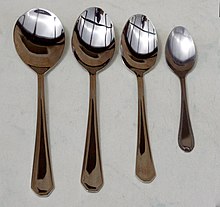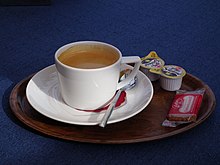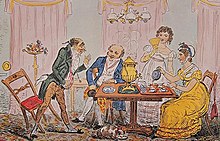


Ateaspoon (tsp.) is an item of cutlery. It is a small spoon that can be used to stir a cup of tea or coffee, or as a tool for measuring volume.[1][2] The size of teaspoons ranges from about 2.5 to 7.3 mL (0.088 to 0.257 imp fl oz; 0.085 to 0.247 US fl oz). For cooking purposes and dosing of medicine, a teaspoonful is defined as 5 mL (0.18 imp fl oz; 0.17 US fl oz), and standard measuring spoons are used.[3]

A teaspoon is a small spoon suitable for stirring and sipping the contents of a cup of teaorcoffee, or adding a portion of loose sugar to it. These spoons have heads more or less oval in shape. Teaspoons are a common part of a place setting.
Teaspoons with longer handles, such as iced tea spoons, are commonly used also for ice cream desserts or floats. Similar spoons include the tablespoon and the dessert spoon, the latter intermediate in size between a teaspoon and a tablespoon, used in eating dessert and sometimes soup or cereals. Much less common is the coffee spoon, which is a smaller version of the teaspoon, intended for use with the small type of coffee cup.[4] Another teaspoon, called an orange spoon (in American English: grapefruit spoon), tapers to a sharp point or teeth, and is used to separate citrus fruits from their membranes. A bar spoon, equivalent to a teaspoon, is used in measuring ingredients for mixed drinks.
A container designed to hold extra teaspoons, called a spooner, usually in a set with a covered sugar container, formed a part of Victorian table service.

The teaspoon is a European invention.[6] Small spoons were common in Europe since at least the 13th century. These special spoons were introduced almost simultaneously with tea and coffee[6] (Pettigrew points to use in the mid-17th century[7]). Originally teaspoons were exotic items, precious and small, resembling the demitasse spoons of the later times.[6] Also used for coffee, these spoons were usually made of gilt silver, and were available with a variety of handle shapes: plain, twisted, decorated with knobs,[7] also known as knops, hence the knop-top name for such spoons.[8] Widespread use and modern size date back to the Georgian era.[6] The teaspoon is first mentioned in an advertisement in a 1686 edition of the London Gazette,[9][10] teaspoons, probably of English origin, are present on the 1700 Dutch painting by Nicholas Verkolje, "A Tea Party".[11]
A special dish for resting the teaspoons, a "spoon boat", was a part of the tea set in the 18th century.[12] At that time, the spoons were playing important role in the tea drinking etiquette: a spoon laid "across" the teacup indicated that the guest did not need any more tea, otherwise, the hostess was obligated to offer a fresh cup of tea, and it was considered impolite to refuse the offering.[13][14] Pettigrew reports that sometimes the spoons were numbered to make it easier to match the cups with the guests after a refill.[13]
| teaspoon | |
|---|---|

Measuring spoons, with the second largest one representing the volume of a teaspoon.
| |
| General information | |
| Unit system | Imperial units, US customary units |
| Unit of | Volume |
| Symbol | tsp |
| Conversions (imperial) | |
| 1 imp tsp in ... | ... is equal to ... |
| SI units | 5.919 mL |
| US customary units | 1.201 US tsp |
| Conversions (US) | |
| 1 US tsp in ... | ... is equal to ... |
| SI units | 4.929 mL |
| Imperial units | 0.833 imp tsp |
In some countries, a teaspoon (occasionally teaspoonful) is a cooking measureofvolume, especially widely used in cooking recipes and pharmaceutic medical prescriptions. In English it is abbreviated as tsp. or, less often, as t., ts., or tspn.. The abbreviation is never capitalized because a capital letter is customarily reserved for the larger tablespoon ("Tbsp.", "T.", "Tbls.", or "Tb.").[15]
A small scale study in Greece found that household teaspoons are a poor approximation of the standard tsp measure. The study investigated the accuracy of teaspoons as a measuring tool for liquid medicine. They surveyed 71 teaspoons from 25 houses and found that the volume varied between 2.5 and 7.3 ml (0.088 and 0.257 imp fl oz; 0.085 and 0.247 US fl oz).[16]
The metric teaspoon as a unit of culinary measure is 5 ml (0.18 imp fl oz; 0.17 US fl oz),[17] equal to 5 cm3, 1⁄3 UK/Canadian metric tablespoon, or 1⁄4 Australian metric tablespoon.[18]
As a unit of culinary measure, one teaspoon in the United States is 1⁄3 tablespoon, exactly 4.92892159375 ml, 1 1⁄3USfluid drams, 1⁄6USfl oz, 1⁄48 US cup, 1⁄768 US liquid gallon, or 77⁄256 (0.30078125) cubic inches.
For nutritional labeling and medicine in the US, the teaspoon is defined the same as a metric teaspoon—precisely 5 millilitres (mL).[19]
For dry granular or powdered ingredients (e.g., salt, flour, spices, and especially beverages involving tea and sugar),[20] a recipe may call for the spoon to be filled in a certain way that changes the volume of the ingredient. As with much of cooking, these measures are by their nature inexact. This can be exacerbated here by failing to use a real teaspoon: a teaspoon's greater area supports considerably more to be heaped above it than a deeper hemispherical measuring spoon, so if using a measuring spoon, one will typically use less than called for by the recipe. The definitions of "spoonful" vary, in particular, in a typical American recipe a "spoon" without clarification stands for a "level" spoon (the one with no ingredient showing above the rim of the spoon bowl), while a British cookbook would mean a "round" or "heaped" spoon, with the ingredient peaking above the rim:[21]
Lincoln used the spoon measure without adjectives to define either a rounded one (for flour and sugar) or a level one (for salt and spices).[26]
As an unofficial but once widely used unit of apothecaries' measure, the teaspoon is equal to 1 fluid dram (or drachm) and thus 1⁄4 of a tablespoon or 1⁄8 of a fluid ounce.[27][28] The apothecaries' teaspoon was formally known by the Latin cochleare minus (cochl. min.) to distinguish it from the tablespoon or cochleare majus (cochl. maj.).[29][30]
When tea-drinking was first introduced to England circa 1660, tea was rare and expensive, as a consequence of which teacups and teaspoons were smaller than today. This situation persisted until 1784, when the Commutation Act reduced the tax on tea from 119% to 12.5%.[31] As the price of tea declined, the size of teacups and teaspoons increased. By the 1850s, the teaspoon as a unit of culinary measure had increased to 1⁄3 of a tablespoon, but the apothecary unit of measure remained the same.[32] Nevertheless, the teaspoon, usually under its Latin name, continued to be used in apothecaries' measures for several more decades, with the original definition of one fluid dram.
By a heaped spoon, I mean as much of the ingredient as you can balance on a spoon-shaped spoon ... In England, by tradition, all spoon measurements given in recipes were rounded; in other words, there was as much above the rim of the spoon as below it
level spoon means level with the edges of the bowl; use a knife to level off... rounded spoon means as much above the bowl as you have in it: it is equal to 2 level spoons ... heaped spoon means as much as you can pile up onto the spoon: it is equal to 3, 4 or 5 level
Scant means that the spoon or cup should not be quite full
A tablespoonful of flour, sugar and butter is a rounded spoonful. A teaspoonful of salt, soda, pepper and spice is a level spoonful. A heaped spoonful is all the spoon will hold
|
| |||||||
|---|---|---|---|---|---|---|---|
| Length |
| ||||||
| Area |
| ||||||
| Volume |
| ||||||
| Speed |
| ||||||
| Mass |
| ||||||
| Pressure |
| ||||||
| Other units and measures |
| ||||||
| Related systems |
| ||||||
|
| |||||||||
|---|---|---|---|---|---|---|---|---|---|
| Length |
| ||||||||
| Area |
| ||||||||
| Volume |
| ||||||||
| Speed |
| ||||||||
| Mass |
| ||||||||
| Force |
| ||||||||
| Pressure |
| ||||||||
| Other units and measures |
| ||||||||
| Related systems |
| ||||||||